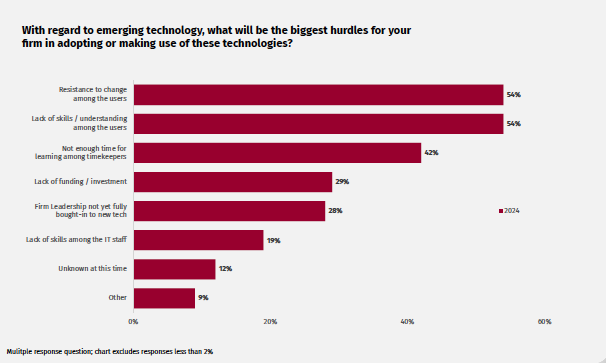ILTA’s 2024 Technology Survey can be expected to show a chasm between small and large law firms’ Gen AI plans and early use, according to an executive summary that has been published ahead of the survey’s release later this month.
While ILTA is at pains to emphasise that Gen AI accounts for only one tenth of its annual survey findings, one of the more interesting details highlighted ahead of its release is that asked: ‘What are your firm’s plans for Microsoft Copilot for Microsoft 365’, just over a third of smaller firms (37%) said “none.” That compares with 0% of the largest firms.
Asked if a pilot of Copilot was already underway, 4% of smaller firms said it is, compared with 50% of the largest firms.

On the business side (as opposed to the practice of law) the largest use cases for Gen AI are cited as ‘Litigation support’ (eDiscovery, training programs etc) and ‘IT Department’ (security awareness training, security, phishing etc). The ILTA survey executive summary authors, Todd Corham, CIO of Saul Ewing Arnstein & Lehr, and Chris Owens, CTO at Kraft Kennedy, observe: “The use of Gen AI in eDiscovery appears to be far more prevalent at larger firms (76% at the largest) than at our more modestly sized organisations (28% at the smallest firms).”
They add: “An even broader discrepancy exists between the largest and smallest firms when reporting on whether Gen AI was used for Marketing and Business Development (14% up to 78% – one of the broadest gaps in this year’s survey). It may be that business-side use cases become the thin end of the AI wedge at many firms in which efforts at risk mitigation (or avoidance) have deemed Gen AI unfit for the practice. Be that as it may, the use of publicly available Gen AI tools may be far more widespread than this survey reports, as the tracking of “stealth” Gen AI use can be elusive.”
While this exec summary is a very short teaser of a much wider report, Corham and Owens, say: “It is easy to see the value of visualising the data in a more granular fashion. Cost, expertise, depth of experience, and overall resources can impact the speed at which organisations can absorb technological change.”
We will wait to see the full report to analyse the rest of its findings in context and the entire findings in more detail, but as a final interesting (albeit predictable) sneak peak, the most challenging aspect of change continues to be driving user adoption, and the biggest hurdle is resistance to change among users and a lack of skills. Training, more than ever, is absolutely key.



